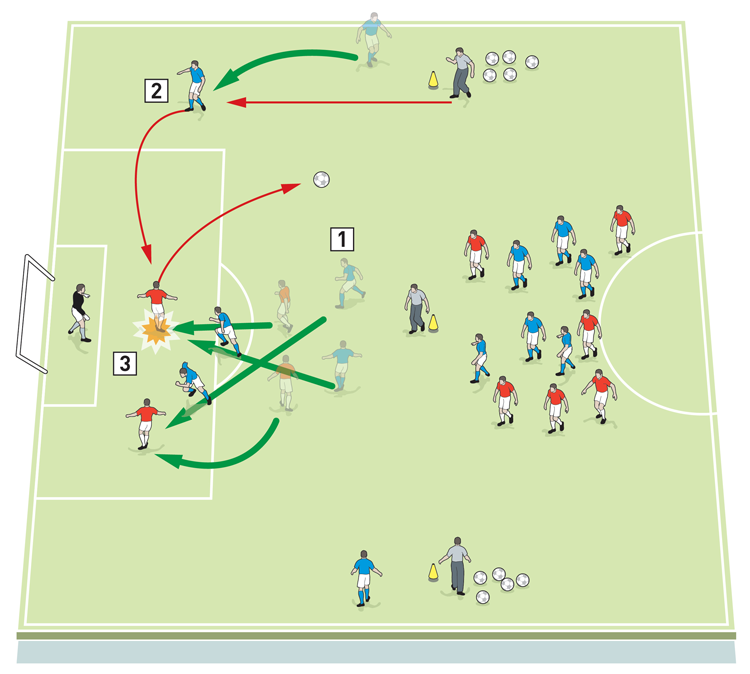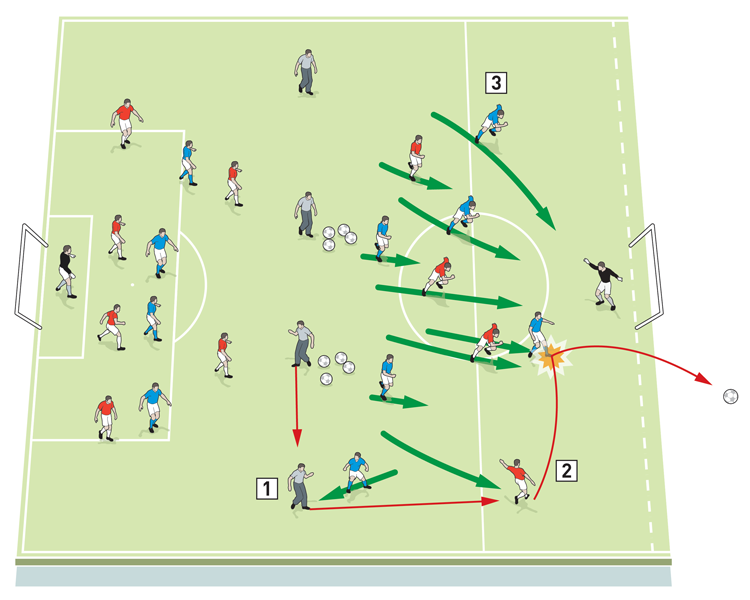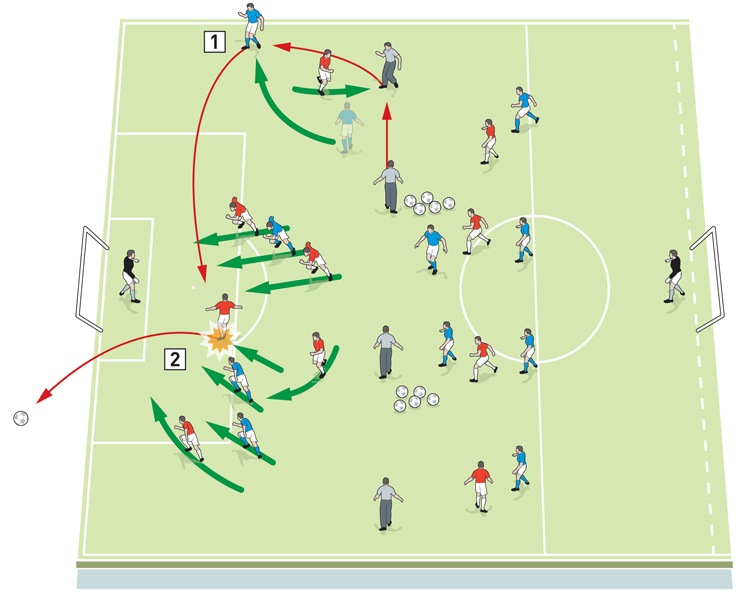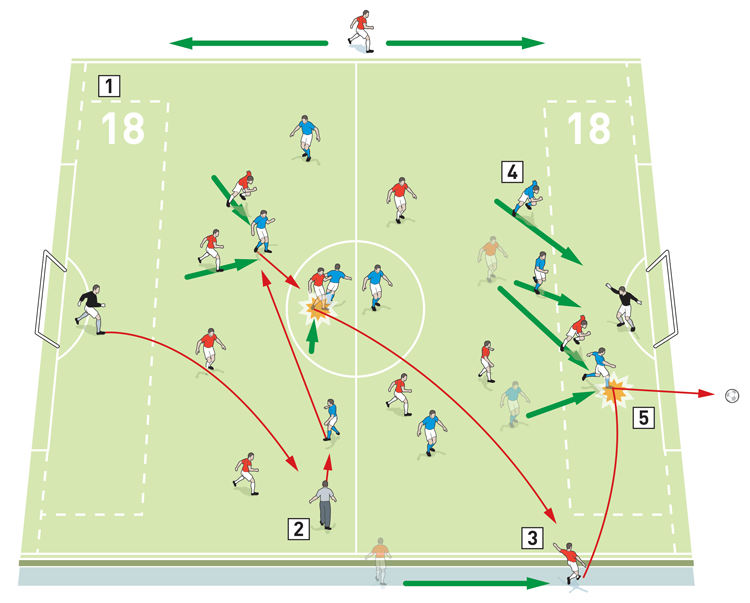You are viewing 1 of your 1 free articles
Defending crosses
This is a session to improve both individual and team defending when an attack comes from wide and balls are crossed into the box.
| Area | Up to three quarters of a pitch |
| Equipment | Balls, bibs, cones, 2 full size goals |
| No. of Players | 20 players + 2 goalkeepers |
| Session Time |
Practice 1: 20mins, Practice 2: 20mins, Practice 3: 20mins |
This is a session to improve both individual and team defending when an attack comes from wide and balls are crossed into the box.
We start the session working on simple defending against different combinations – in 1v1, 2v1, 2v2 and 3v2 situations. We are looking to improve the defenders’ body orientation, so they control the ball when it is coming across the penalty area.
In the second exercise, we put the technique under pressure in a more game-like situation, with plenty of chances to defend against lateral crosses delivered into the penalty area.
Finally we play a 9v9 game using additional external wide players to cross the ball into the box. Recovering defenders work as a back four to cover the attack and defend the goal from repeated and varied styles of cross.
What do I get the players to do?
Practice 1
We set up on half a pitch with a full size goal and a goalkeeper at one end, as shown. We’re using 18 outfield players, split into 10 attackers and eight defenders.
Play starts with one of the coaches playing a ball down the line for a wide player to cross into the penalty area. As the wide man is making his run down the line, an attacker and a defender go 1v1 against each other in the centre of the pitch, preparing to meet the cross.
Starting outside the penalty area, as shown [1a], the defender must track the central attacker, staying goal-side and either forcing the attacker to make a mistake, or making a well timed tackle to clear the ball.
1a

2. In the centre, the first attacker goes 1v1 against the first defender, with the attacker trying to meet the cross
3. The defender tracks the attacker. He must stay goal-side and make a well-timed tackle to clear, or force the attacker into a mistake
Repeat with more 1v1s, alternating the side the cross comes from and varying the type of delivery, such as low and driven or high and long.
After all players have sufficiently experienced the 1v1, repeat the drill, using different attacking and defending combinations: 2v1, 2v2, as shown [1b], and 3v2.
1b

2. Vary the side the cross comes from and the style of delivery
3. The position of the defender is key to stopping the attack. Here he stays goal-side and clears the cross
Practice 2
Next we set up on three quarters of a pitch with a full size goal and goalkeeper at each end. We’re using 20 outfield players, set up as shown [2a], with a back four and two pivots defending against four attackers in each half of the playing area.
2a

2. The blue full back goes to challenge the coach, leaving space behind for the attacking red winger to receive down the line and cross
3. The three remaining defenders and two pivots cover the space and look to clear any crosses into the box
Play starts with one of the central coaches passing to a wide coach. The nearest full back on the defending team goes towards the coach, leaving space behind for the attacking winger to receive a pass down the line and cross into the area in front of the goal. The three remaining defenders and the two pivots should cover the space and look to clear any crosses into the box.
Next, repeat the drill in the other half of the playing area, going in the opposite direction. The other back four and their two supporting pivots now defend the balls played into the box, as shown [2b]. Alternate attacking ends and vary the side the cross comes from and the kind of delivery made.
2b

2. Here the red back four and two pivots defend and a well-positioned defender clears the ball
Practice 3
We set up between the penalty boxes of a pitch, with a full size goal and goalkeeper at each end. Mark out an 18-yard zone in front of each goal. We’re using 20 outfield players, split into two teams of nine, plus two external wingers who support just one of the teams from outside the touchline. The game is played in the whole area but we set up with a 5v4 on each side of the halfway line and with the players locked into the halves of the pitch they start in, as shown [3].
3

2. The practice starts with a pass from the keeper to the coach, who sets up play
3. One team attacks with the support of two external wide players. All scoring chances by this team must come from a cross by one of the external players
4. Players cannot enter the zone in front of the goal before the ball crosses into that zone
5. Here the blue defender positions himself perfectly to intercept the ball and clear the cross
The practice starts with a pass from the keeper to the coach, who sets up play. The team with the two external wide players (the reds) can only score through a chance created by a cross from one of these wingers. The other team (the blues) should attack through the middle and, when under attack, they must position themselves to successfully defend against the crosses. The team with the extra wide players gets three chances to score from crosses and if they fail, switch the wide players to supporting the other team. No player can enter the 18-yard zone before the ball crosses into that zone.
What are the key things to look out for?
Defenders should be aware of the incoming attacker and make sure they are between the attacker and the goal, staying goal-side to hold up play or head away from danger.
In a back four, when one defender goes to the wide attacker, the other players must move to cover any defensive holes left by this move. Defenders should move towards the attacker, pressing and forcing play. But remember, the attacker has to beat the defender, so there’s no need to commit to a tackle too early. The defender has three options in the 1v1 – steal the ball, track the movement of the attacker, or commit to a tackle.
What are the typical mistakes players might make and how do I avoid them?
Defenders can get over eager and dive in when making a challenge, giving away a penalty in the area, or go too early and allow the attacker to catch them out. In aerial battles the defenders can jump too soon or too late and allow the attacker to beat them to the ball. They can also be caught ball watching and lose the position of the defender, making it harder to defend the cross.
Related Files
Editor's Picks
Deep runs in the final third
Using the goalkeeper in build-up play
Pressing principles
Intensive boxes drill with goals
Penetrating the final third
Creating and finishing
My philosophy
Pressing initiation
Compact team movement
Coaches' Testimonials

Alan Pardew

Arsène Wenger

Brendan Rodgers

Carlos Carvalhal

José Mourinho

Jürgen Klopp

Pep Guardiola

Roy Hodgson

Sir Alex Ferguson

Steven Gerrard
Coaches' Testimonials

Gerald Kearney, Downtown Las Vegas Soccer Club

Paul Butler, Florida, USA

Rick Shields, Springboro, USA

Tony Green, Pierrefonds Titans, Quebec, Canada
Join the world's leading coaches and managers and discover for yourself one of the best kept secrets in coaching. No other training tool on the planet is written or read by the calibre of names you’ll find in Elite Soccer.
In a recent survey 92% of subscribers said Elite Soccer makes them more confident, 89% said it makes them a more effective coach and 91% said it makes them more inspired.
Get Monthly Inspiration
All the latest techniques and approaches
Since 2010 Elite Soccer has given subscribers exclusive insight into the training ground practices of the world’s best coaches. Published in partnership with the League Managers Association we have unparalleled access to the leading lights in the English leagues, as well as a host of international managers.
Elite Soccer exclusively features sessions written by the coaches themselves. There are no observed sessions and no sessions “in the style of”, just first-hand advice delivered direct to you from the coach.









